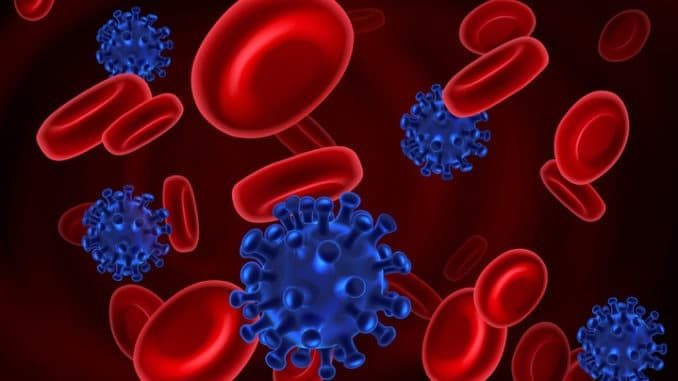
Dr Paul Lambden discusses the differences between sepsis and septicaemia and the important symptoms to look out for
I qualified as a doctor in 1975 at Guy’s Hospital. The other day I looked out my copy of A Short Textbook of Medicine which was the undergraduate textbook of choice, written by three Guy’s consultants. The third edition, published in 1968, did not index the words septicaemia or sepsis anywhere in the 600-odd pages of text. Even by the seventh edition, published in 1982, the conditions were still not identified. Now ’septicaemias and ‘sepsis’ are words which are commonly reported, and are often used interchangeably; in fact, they are not the same.
‘Septicaemia’ is infection in the blood stream (coming from the Greek ‘septin’– putrid poison with the suffix –aemia, meaning blood. Septicaemia is the result of infection getting into the bloodstream from anywhere in the body.
It is common for small numbers of bacteria to get into the blood, but they are quickly destroyed by the body’s defence systems. However, when the infection is with virulent (extremely harmful) or when there are large numbers of bacteria, it is very serious because the bacteria, together with the toxins they produce, can spread throughout the body with great speed. The condition can rapidly become life-threatening.
Many types of bacteria can cause septicaemia and, although they can emanate from anywhere, the common originating locations are:
- the kidney and urinary tract infections;
- the lungs, from infections such as pneumonia;
- abdominal and bowel infections;
- meningitis.
The risks are also increased if:
- the individual is very young or old;
- the immune system has been compromised – such as with leukaemia, cancer chemotherapy or HIV;
- there is long-term chronic illness;
- there is a severe wound or burn;
- there is contamination of indwelling tubes, such as urinary catheters.
When septicaemia occurs, the patient will usually rapidly become unwell. The principal features are:
- fever;
- rapid respiration;
- tachycardia (rapid heart rate).
As the infection progresses, further symptoms will appear:
- nausea and vomiting.
- purplish blotchy rash which does not blanch on pressure (like the meningitis rash with a glass);
- confusion and disorientation;
- the features of shock, with reduced urinary output and shutdown of the blood circulation.
Consequences and complications
The consequences and complications of septicaemia occur as the condition progresses. They are all very serious and may be fatal.
- Sepsis, which is defined as an extreme inflammatory response to infection. The body activates a vigorous immune response to the infection which involves the release of chemicals which, in turn, produce generalised inflammation throughout the body. In simple terms, the body’s defence is mobilised to destroy the infection but the exuberant response attacks the body tissues as well.
The inflammation can lead to clotting of blood within blood vessels (intra-vascular clotting) resulting in blood being unable to reach some areas, and also causing vessels to leak.
- Septic shock is a consequence of sepsis where the blood pressure falls. The combination of vessel obstruction from clotting and falling blood pressure results in inadequate blood and, therefore, oxygen reaching vital organs which start to shut down. The kidneys, liver and lungs may fail.
Septic shock is a medical emergency and patients are normally admitted to intensive care units.
- Acute respiratory distress syndrome (ARDS) is a third complication of septicaemia and, specifically, is the situation which prevents sufficient oxygen from reaching the lungs and blood. The consequence may be permanent lung damage in those people who survive. In hospital, treatment of such patients may include artificial respiration using a ventilator. The condition may also cause brain damage through anoxia (lack of oxygen).
The challenge of diagnosis
The diagnosis of septicaemia can be a considerable challenge, as exemplified by tragic news reports when the diagnosis was not made, or made late, and a patient died. Diagnosis is usually based on medical history and physical examination during which the signs of septicaemia, such as fever, low blood pressure and the presence of specific infections (such as pneumonia, cellulitis, kidney infection or meningitis) should be identified. It sounds easy, but it can be extremely difficult.
The patient will undergo tests, including blood tests, assessment of other bodily fluids (such as urine, sputum and any wound discharge), X-rays, ultrasound and scans. Clotting studies will also be important when the diagnosis is suspected (in case of intravascular clotting).
Treatment will be started as quickly as possible because of the nature of the medical emergency it poses. It is treated in hospital, usually in an intensive care unit. The success of the treatment will depend on a number of factors:
- the speed of diagnosis and the stage of the condition when treatment is initiated;
- the nature of the infection and its virulence;
- the originating location of the infection;
- the age of the patient;
- the overall health of the patient;
- responsiveness to, and tolerance of, medication.
Antibiotics are used in the treatment of both septicaemia and sepsis. If a diagnosis of sepsis is suspected, speed is of the essence and a ‘broad-spectrum’ antibiotic, effective against a range of infections, will be commenced. Once the causative organism of the disease is identified, the treatment may be changed to a specific antibiotic effective against the particular organism.
Frequently, the patient also requires fluid replacement and may need treatment to prevent the blood clotting inside the blood vessels. Oxygen will also be supplied through a mask or, in more severe cases, through a ventilator.
Prevention and risk reduction
It may be quite difficult to reduce the risk of septicaemia because of the challenges associated with the acquisition and recognition of bacterial infections and their consequences. Effective treatment of localised bacterial infections, in the lung, kidney or elsewhere, may prevent the septicaemia and the damage caused by sepsis.
If the immune system is compromised for any reason, or if other risk factors apply, it may help if:
- smoking is avoided;
- a healthy diet is eaten;
- care is taken with hand-washing to avoid contamination;
- exercise plans are adopted;
- there is no use of illicit drugs, particularly if administered with non-sterile equipment.
Septicaemia and sepsis are very serious conditions. Published data shows that, in the United Kingdom, there are about 52,000 deaths a year from sepsis, and a 35% mortality rate; gGlobally there are between six and eight million deaths annually. To put the UK figures into proportion, sepsis deaths are responsible for a quarter of all UK maternal deaths and the cause of more deaths than from breast, bowel and prostate cancer put together.
The data provided by the charity Sepsis Research are chilling; every hour that treatment of the disease is delayed reduces the survival by seven per cent. Sepsis is one of the few conditions that can kill a healthy individual within hours. Frightening, isn’t it?
Further information is available on the Sepsis Research website.
sepsisresearch.org.uk
89 Seaward Street
Glasgow G41 1HJ
07379 989191


Be the first to comment